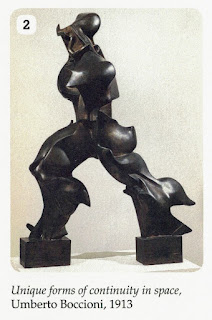Motion is the state of a body that is not at rest. In other words, its position is continuously changing.
In most cases, motion is quite difficult to show in a single image.
There are three states of motion in visual communication:
• Real motion: when a body is really moving.
• Absolute rest: when there is no motion.
• Virtual or apparent motion: when an object is not in motion, but it appears to the viewer To be moving
Painting, architecture and sculpture also communicate a sense of motion. Some of the resources they use are:
• repetition of shapes
• curved, oblique and broken lines
• imbalance and asymmetry of the elements Graphic and audiovisual arts use blurring and various types of motion lines to show movement.
Historically, artists have looked for ways to represent motion, both in 2-D in 3-D works.
Sometimes, representing motion was not always the artists' main aim, an be technically difficult to achieve. However, motion is usually present in art even in the most rigid ones.
1. Motion in art is represented in various ways.
One technique is to use a chaotic composition crowded with people. A good example is the jumbled scene by Pieter Brueghel the Elder
(1525-1569), where we see dozens of characters frozen in action.
2. In the 20th century, avant-garde artists experimented with ways to represent movement.
Futurist artists used motifs, such as machines, animals, war and cities, to show the energy of motion.
3. Around 1960, a new movement called Kinetic Art emerged. In this type of art, the artwork moves or has an element of motion.
4. In some abstract artworks, the shapes and colours appear to move. This is due to the type of shapes used, as well as the composition and the contrast of colours. Some artists, such as those belonging to the Op Art movement, used geometric optical illusions and the psychology of perception to explore the sensation of motion.
Motion lines
In comics, the graphics that represent motion in characters and obiects are called motion lines.
Simple speed lines are a resource that show in which direction a character is moving quickly.
It can be done in several ways.
Reinterpret these photos using motion lines.
Use black felt-tip pens of different thicknesses.








